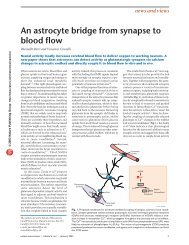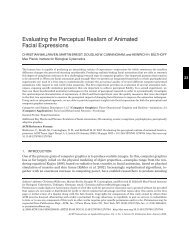Chapter 12: Centrioles
Chapter 12: Centrioles
Chapter 12: Centrioles
You also want an ePaper? Increase the reach of your titles
YUMPU automatically turns print PDFs into web optimized ePapers that Google loves.
CENTRIOLES<br />
In suitably stained histological sections examined with the light microscope a<br />
pair of short rods, the centrioles, are seen in a specially differentiated region of the<br />
juxtanuclear cytoplasm called the centrosome, or cell center. The position of the<br />
centrosome was long used as an indication of the polarity and symmetry of the cell, and<br />
a line passing through the center of the nucleus and through the centrosome was defined<br />
as the cell axis. In secretory epithelial cells the pair of centrioles (diplosome) is often<br />
located in the supranuclear cytoplasm partially surrounded by the Golgi apparatus.<br />
The position of these organelles was believed to determine the polarity of the cell and<br />
the direction of its secretion.<br />
The centrioles were observed to double in number immediately before cell<br />
division, one pair migrating to the opposite pole of the nucleus. After the breakdown of<br />
the nuclear envelope the mitotic spindle developed with a diplosome at each pole. The<br />
centrioles were thus considered to play an important role in cell division, serving as<br />
centers for organization of the spindle apparatus. It was logical to attribute the doubling<br />
of the centrioles immediately before cell division to a process of division comparable to<br />
binary fission of bacteria. They were therefore regarded as self-duplicating organelles<br />
exhibiting continuity from one cell generation to the next. A diploid cell generally had a<br />
single pair of centrioles, but in polyploid cells there was a pair for each chromosome set<br />
so that megakaryocytes of bone marrow or multinucleate giant cells of bone may have<br />
30 or more. An exception to this correspondence between ploidy and number of<br />
centrioles was recognized in the case of ciliated epithelial cells. A remarkable<br />
proliferation of centrioles was observed as an initial event in the differentiation of cilia.<br />
The resulting centrioles took up a position immediately beneath the plasmalemma and<br />
served as the basal bodies of the developing cilia.<br />
Electron microscopy demonstrated that centrioles were hollow cylindrical structures<br />
with nine evenly spaced triplet microtubules in their walls (de Harven and<br />
Bemhard, 1956; Bessis et al., 1968). Their duplication in the mitotic cycle and their<br />
continuity in the daughter cells were confirmed but the traditional views on the<br />
mechanism of centriole duplication proved to be incorrect.<br />
Diagram of centriole replication prior to cell division. Each member of the original pair (A) induces<br />
formation of a new centriole perpendicular to a specific region of its wall (B and C). The two<br />
diplosomes so formed take up positions at opposite poles of the mitotic spindle (D). In B and C the<br />
centrioles are depicted in longitudinal section.









